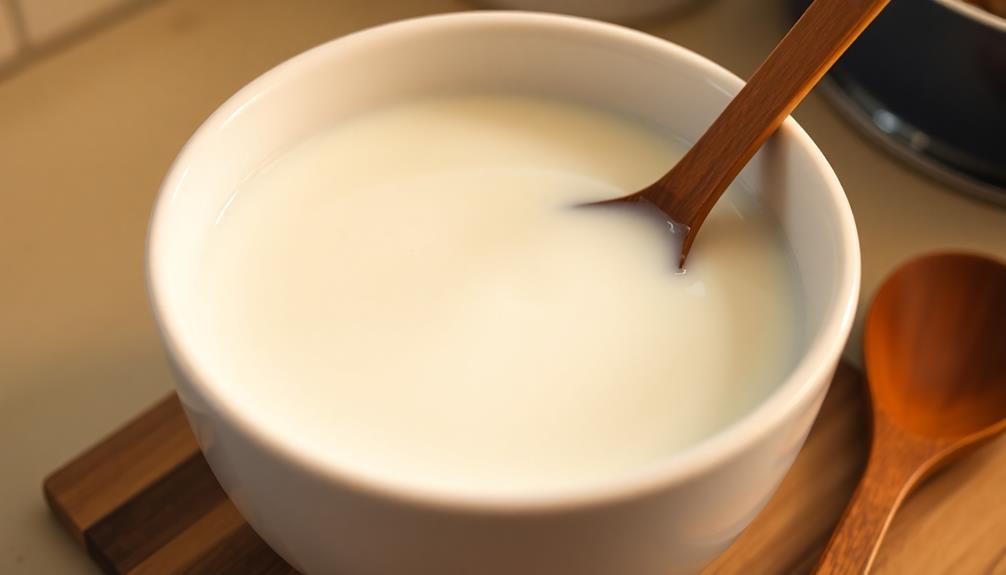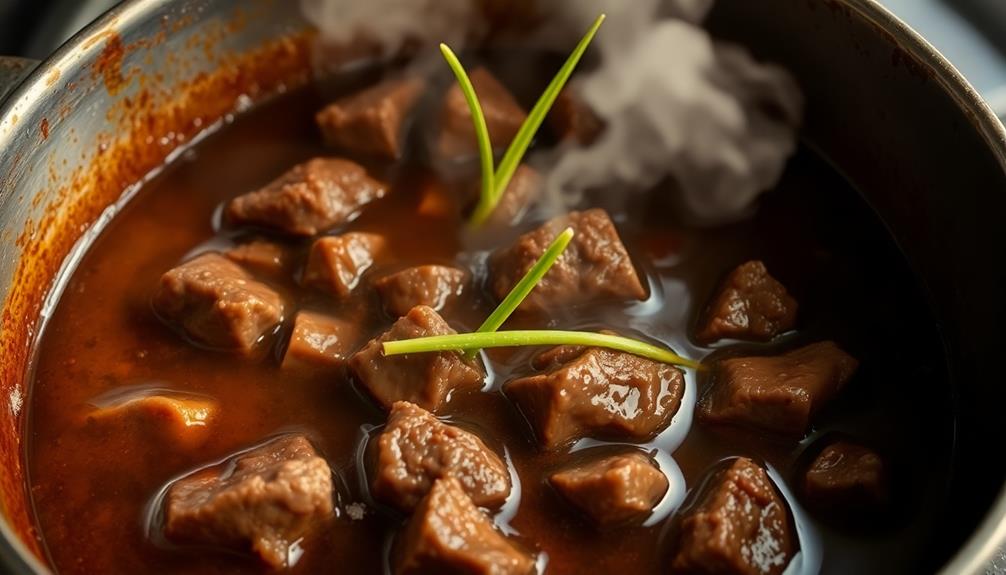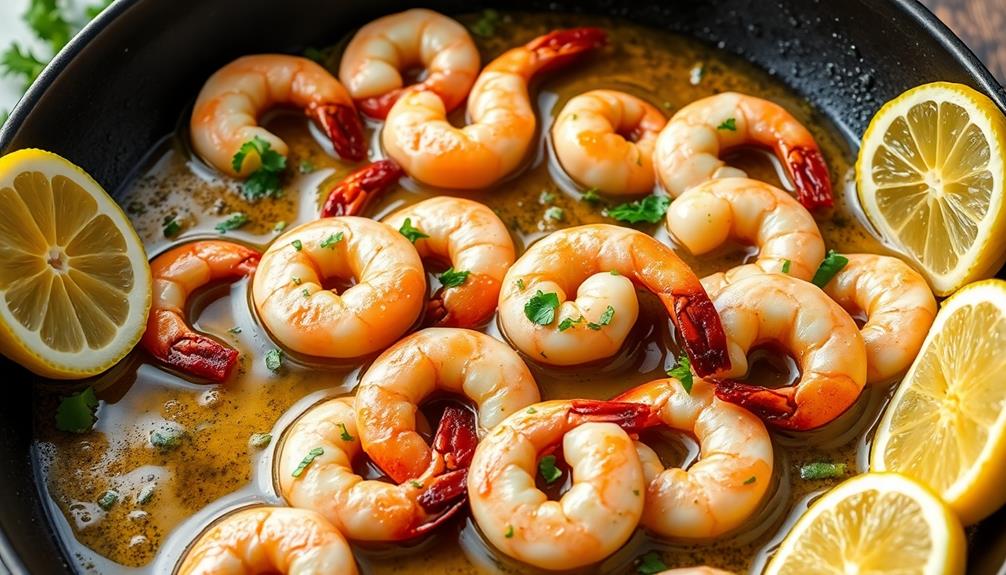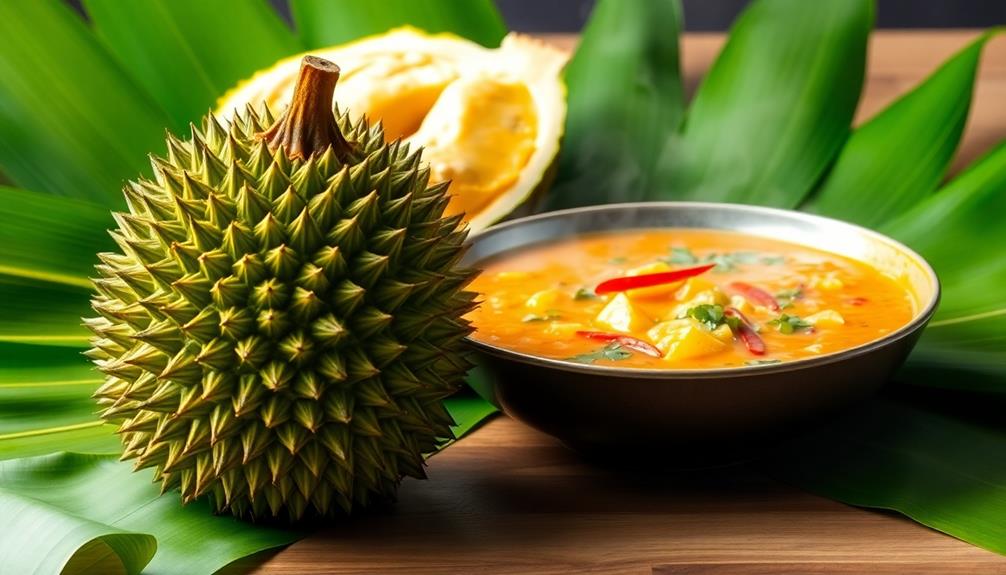Rawon, the captivating black beef soup from East Java, Indonesia, has a rich history dating back to the 16th century. This beloved dish features a key ingredient – keluak nuts – which give it its unique dark color and earthy flavor. Rawon reflects eco-friendly cooking practices and cherished local traditions passed down for generations. It's a nourishing stew that showcases Indonesia's vibrant culinary heritage, with a carefully prepared spice paste that infuses the tender beef with layers of complex flavors. Serve it with steamed rice and sambal for an authentic taste of Java. There's so much more to discover about this enticing dish. For those looking to experience the true essence of Indonesian street food, a bowl of rawon is a must-try. Its robust and hearty flavors, coupled with the bustling atmosphere of local food stalls, create a memorable dining experience. Whether enjoyed in a bustling market or a family kitchen, rawon offers a taste of Indonesia’s culinary soul.
Key Takeaways
- Rawon is a traditional beef stew from Surabaya, East Java, Indonesia, known for its distinctive black color from the use of keluak nuts.
- The dish reflects Indonesia's rich culinary heritage, with its origins dating back to the 16th century and its use of a carefully prepared spice paste.
- The cooking process involves simmering beef in a blend of spices, coconut milk, and aromatic ingredients like lemongrass and galangal, resulting in a flavorful and tender dish.
- Rawon is traditionally served with steamed white rice and sambal, providing a balance of flavors and textures that showcase the depth of Indonesian cuisine.
- The dish's preparation and presentation embody the importance of spices in Indonesian culinary arts, as well as the eco-friendly practices in traditional cooking methods.
History
Rawon, the captivating black beef soup, has a rich history rooted in the culinary traditions of East Java, Indonesia. This beloved dish has been enjoyed for centuries, with its origins dating back to the 16th century.
The unique black color of the soup comes from a blend of spices, including the key ingredient, keluak nuts. These dark, earthy nuts are native to the region and have been used in Indonesian cooking for generations. The preparation of rawon often reflects eco-friendly practices, similar to those in wood stove usage, where traditional methods emphasize sustainable sourcing and minimal waste eco-friendly practices.
Over time, the recipe for rawon has been passed down through families, each adding their own unique twist.
Today, the dish is a cherished part of Indonesian cuisine, with every region having its own interpretation. Some versions may feature different cuts of beef, while others experiment with additional vegetables or seasonings.
Despite these variations, the core essence of rawon remains the same – a deeply flavorful and nourishing soup that warms the soul.
Recipe
Rawon is a traditional Indonesian beef stew dish that originates from the city of Surabaya in East Java. The dish is characterized by its distinctive dark, almost black color, which comes from the use of keluak nuts, a unique Indonesian ingredient that lends the stew a rich, earthy flavor.
Cooking rawon at home may seem daunting, but with the right ingredients and a few simple steps, you can recreate this beloved dish in your own kitchen. The key to achieving the perfect rawon lies in the careful preparation of the spice paste, which forms the foundation of the stew.
- 2 lbs beef chuck, cut into 1-inch cubes
- 2 cups beef stock
- 3 lemongrass stalks, bruised
- 2 kaffir lime leaves
- 1 inch ginger, grated
- 2 tbsp tamarind paste
- 2 tsp palm sugar
- Salt and pepper to taste
In a large pot, brown the beef over high heat until the edges are seared. Remove the beef from the pot and set aside.
In the same pot, sauté the spice paste until fragrant, then add the lemongrass, lime leaves, ginger, tamarind paste, and palm sugar. Pour in the beef stock and return the beef to the pot.
Simmer the stew for 1-1.5 hours, or until the beef is tender and the flavors have melded together.
When serving, be sure to remove the lemongrass and lime leaves. This dish is best enjoyed with steamed white rice and a side of sambal, allowing you to customize the heat and flavor to your preference.
Rawon is a true taste of Indonesian cuisine that's sure to leave a lasting impression on your palate.
Cooking Steps
Let's start by preparing the spice paste.
Once you've got that ready, add the beef and let it soak up all those amazing flavors.
Next, pour in the coconut milk and let it all simmer until the beef is nice and tender.
Step 1. Prepare the Spice Paste

To make the spice paste for the rawon, begin by gathering all the necessary ingredients. You'll need shallots, garlic, candlenuts, coriander, cumin, cloves, and shrimp paste.
Grab a blender or food processor, and add the shallots, garlic, and candlenuts. Pulse until they're finely chopped.
Next, add the coriander, cumin, and cloves. Blend everything together until it forms a smooth, fragrant paste. Don't forget to scrape down the sides of the blender as you go.
Finally, stir in the shrimp paste and give it a good mix. The spice paste is now ready to use in your rawon recipe.
It's important to prepare the paste carefully, as the flavors will be the foundation for your delicious black beef soup. With all the aromatic spices, your kitchen will be filled with an incredible aroma.
Get ready to enjoy the authentic taste of rawon!
Step 2. Add the Beef

With the aromatic spice paste ready, you can now turn your attention to the star of the dish – the beef.
Grab your trusty knife and start cutting the beef into bite-sized cubes. Don't worry about getting them perfectly uniform; the beauty of this dish is in its rustic charm.
Once the beef is prepped, it's time to add it to the simmering pot of spices. Gently drop the cubes into the fragrant liquid, making sure they're fully submerged.
Now, it's all about letting the flavors meld together. Cover the pot and let the beef simmer for about an hour, or until it's fork-tender and infused with the rich, earthy notes of the spice paste.
The longer you let it cook, the more the flavors will deepen and develop. Be patient and resist the temptation to lift the lid too often, as that can disrupt the simmering process.
Soon, your kitchen will be filled with the irresistible aroma of authentic Rawon.
Step 3. Add the Coconut Milk

After the beef has simmered for an hour, you'll want to add the coconut milk. It's time to give this dish a rich, creamy texture! Grab your can of coconut milk and slowly pour it into the pot.
Stir the mixture gently, making sure the coconut milk blends evenly with the broth. You'll notice the soup start to thicken as the coconut milk does its magic. This technique of adding creamy elements is reminiscent of traditional Brazilian dishes that often incorporate rich ingredients.
Now, let's add a few more ingredients to really make the flavors pop. Toss in the lemongrass, kaffir lime leaves, and galangal. These aromatic herbs will infuse the soup with a fragrant, earthy aroma.
Give everything a good stir, then let the soup simmer for another 30 minutes. This allows the coconut milk to fully incorporate and the spices to meld together.
As the soup simmers, your kitchen will be filled with the most tantalizing scents. Get ready, because the best part is about to happen – it's time to serve this delicious Rawon!
Step 4. Simmer Until Beef Is Tender

The beef's simmering is crucial to achieving the desired tenderness. Grab your spoon and get ready to watch the magic happen!
Gently lower the heat and let the flavors meld together. As the beef simmers, it'll become more and more tender with each passing minute. You'll know it's ready when you can easily pierce it with a fork.
Don't be tempted to rush the process – take your time and let the beef do its thing. Stirring occasionally ensures even cooking. The longer you simmer, the more the beef will absorb all those delicious spices.
Before you know it, you'll have melt-in-your-mouth beef that's bursting with flavor.
Once the beef is fork-tender, you're ready for the next step. Taste the broth and adjust the seasoning if needed. A little salt and pepper can really make the flavors pop.
Now you're one step closer to enjoying a steaming hot bowl of Rawon. Get ready for an amazing culinary adventure!
Step 5. Garnish With Fried Shallots

Fried shallots make for a tasty and crunchy garnish that adds the perfect finishing touch to your Rawon. They bring a wonderful crunch and a touch of sweetness that complements the rich, savory flavors of the beef stew.
To make the fried shallots, simply thinly slice some fresh shallots and gently fry them in hot oil until they're golden brown and crispy. Be careful not to overcrowd the pan, as you want the shallots to have enough room to cook evenly.
Once they're perfectly fried, remove them from the oil and let them drain on a paper towel-lined plate. Sprinkle the crispy fried shallots over the top of your steaming hot Rawon, and enjoy the contrast of textures and flavors.
The crunchy shallots add a delightful finishing touch that takes this traditional Indonesian dish to the next level.
Final Thoughts
Ultimately, Rawon is a captivating Indonesian dish that showcases the depth and complexity of local cuisine. The robust flavors and unique black color of the broth make it a truly memorable dining experience.
While the recipe may seem daunting at first, the payoff is well worth the effort. Once you've mastered the technique, you can experiment with different cuts of beef or even try your hand at making your own spice paste.
Beyond the culinary delights, Rawon also offers a glimpse into the rich cultural heritage of Indonesia. Each bite tells a story of the country's diverse spice trade and centuries-old cooking traditions.
Whether you're a seasoned Indonesian food enthusiast or a curious newcomer, Rawon is sure to leave a lasting impression. So why not gather your ingredients and embark on a flavorful journey to the heart of Java? Your taste buds will thank you.
Frequently Asked Questions
What Is the Origin of the Name "Rawon"?
The term "rawon" likely originated from the Javanese word for a savory stew, reflecting its deep, complex flavors. Its precise origins are unclear, but the dish has become a beloved part of Indonesian culinary tradition.
How Long Does It Take to Prepare Rawon?
To prepare it, it'll take you around 2-3 hours. The process involves marinating the meat, sautéing the spices, and simmering the dish to allow the flavors to blend thoroughly.
Can Rawon Be Made Without Beef?
You can certainly make this dish without beef. Many alternative proteins like chicken, lamb, or even plant-based options can work just as well. Get creative and experiment to find your preferred version.
Is Rawon Suitable for Vegetarians or Vegans?
Rawon is typically made with beef, so it may not be suitable for vegetarians or vegans. You'd need to use alternative protein sources like tofu, tempeh, or mushrooms to make a vegetarian or vegan version of this dish.
Can Rawon Be Frozen and Reheated?
Yes, you can freeze and reheat most soups, including those without meat. Just be sure to cool the soup completely before freezing it. When ready to serve, thaw it in the refrigerator and reheat it on the stove or in the microwave.










